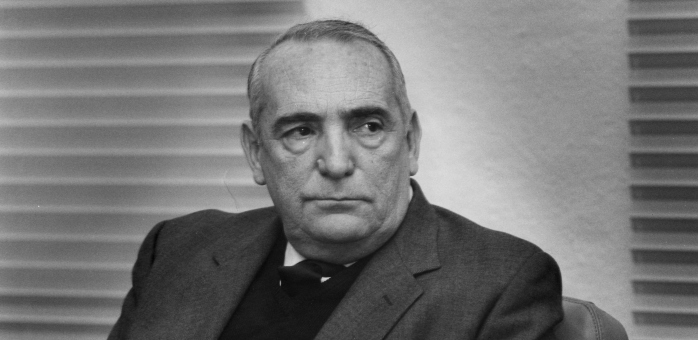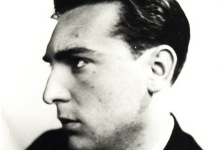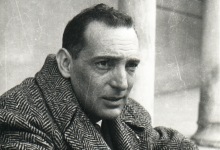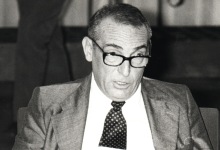Vicente Aguilera Cerni was born on August 15, 1920 in Valencia. At just 17 years old, in the midst of the civil war, he joined the Unified Socialist Youth and left for the front. In Madrid he is in charge of directing the magazine of the organization, "Trincheras", a combative magazine for the army in the Central-Levante area. As John Angel Blasco points out, "here we already have, fully defined, the subsequent Aguilera: a committed intellectual, at the service of freedom and progress".
His early studies as an art historian focus on his interest in Valencian "primitives". In the 1950s, Vicente Aguilera made several essays whose central theme is artistic creation. These essays are a turning point in his professional career, because as a result of his publication, Vicente Aguilera Cerni receives offers from artists who need a critic to comment on and recognize his work.
This is how his artistic knowledge and aided by his literary passion that gives him a simple narrative, Vicente Aguilera becomes a recognized art critic.
Since the 1950s, despite his first medievalist vocation, he appeared as a promoter of criticism and study of avant-garde art in Valencia. He will be the leading theorist and driver of artistic groups such as "Parpalló" (1956), "Chronicle of Reality" (1964) and "Before Art" (1968), as well as directing and publishing the magazines "Arte vivo" and "Suma y sigue del arte contemporáneo", authentic revulsive in a Franco Spain. From grupo Parpalló was born "First joint exhibition of Spanish normative art" that takes place at the Ateneo Mercantil de Valencia in 1960. The term "regulatory art", coined by Aguilera himself, defines art "that occurs according to intentionality, as moral duty and service to good."
Aguilera's abundant bibliographic work on Spanish themes and artists, as well as its activities as a member of the artistic groups cited are a sign of its importance to Valencian and Spanish culture, although we must not forget its international aspect, if it is more noticeable and transcendent than the national one.
Between 1955 and 1975 it was the most international name of Spanish culture.
Throughout his professional career, he collaborated in prestigious European and South American periodicals; participated in multiple congresses with universally renowned personalities; and was part of numerous international juries in the company of illustrious art critics such as Argan, Dorfles or Francastel.
Throughout his career he has received numerous awards and distinctions. It is worth noting the International Prize for Art Criticism at the XXIX Venice Biennale in 1959 and the recognition in its own land, in 1989, with the award of the Premi de les Lletres de la Generalitat Valenciana "in view of the importance of his work as an essayist and critic, to the diversity of his publications in relation to the study , dissemination and promotion of culture and art, as well as for its international projection". On May 4, 1990, he was awarded an honorary doctorate by the Polytechnic University of Valencia (UPV).
Vicente Aguilera was until the end of his days an active member in the artistic scene: founder and lifetime director of the Museum of Contemporary Art of Vilafamés; member of the Board of Trustees of the Spanish Museum of Contemporary Art in Madrid; member of the Governing Board of the Museum of Contemporary Art of Elche; he chaired the Spanish Association of Art Critics and the Valencian Council of Culture of the Valencian Generality, between 1994 and 1996; honorary president of the Spanish Association of Art Critics; Academic of Fine Arts of San Carlos; corporate member of the International Association of Art Critics; director of the international art magazine "Cimal", corresponding Academic of the Royal Academy of Fine Arts of San Carlos de Valencia and Corporate Member of the International Association of Art Critics.
In 2003 the Popular Museum of Contemporary Art of Villafamés changed its name to Museu d'Art Contemporani "Vicente Aguilera Cerni" of Vilafamés, because it is considered the result of the extraordinary vision and intuition of the future of the distinguished art critic, who was able to capture in this museum background the artistic context in which he lived.
The conception and management of the Museum, as well as the excellent documentation of its personal library preserved in the International Center for Artistic Documentation of Vilafamés (CIDA) maintain in this small town in the interior of the province of Castellón, the spirit of this figure who managed to bring art closer to the people and who, today, still persists following his example: look to the past of the province of Castellón, the spirit of this figure who managed to bring art closer to the people and who, today, still persists following his example: look to the past , build the present and intuit the future.







